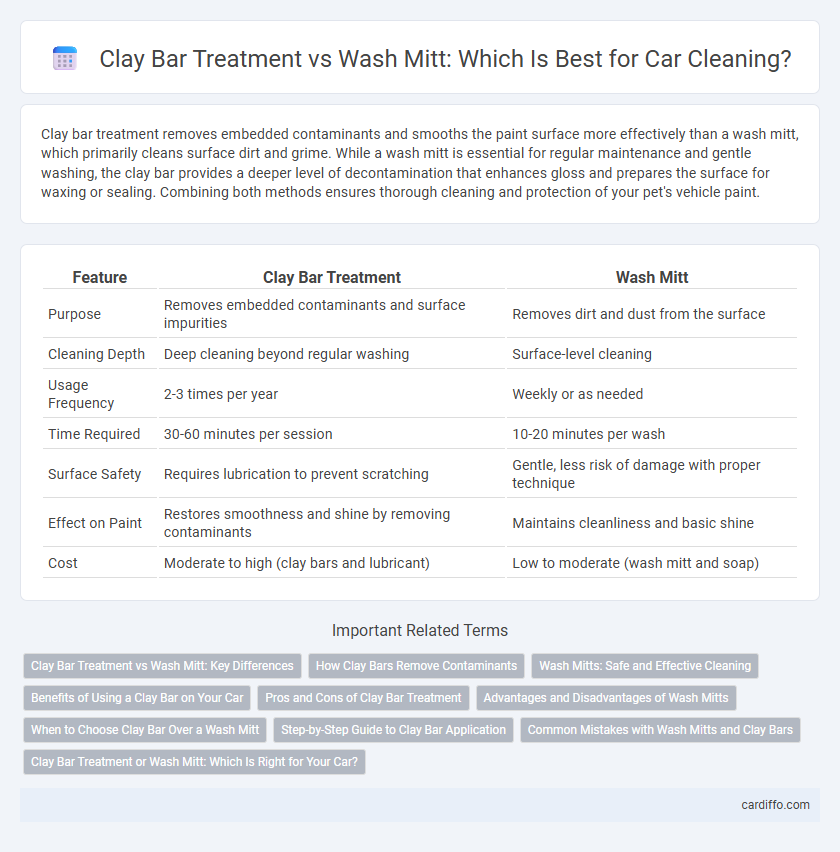Clay bar treatment removes embedded contaminants and smooths the paint surface more effectively than a wash mitt, which primarily cleans surface dirt and grime. While a wash mitt is essential for regular maintenance and gentle washing, the clay bar provides a deeper level of decontamination that enhances gloss and prepares the surface for waxing or sealing. Combining both methods ensures thorough cleaning and protection of your pet's vehicle paint.
Table of Comparison
| Feature | Clay Bar Treatment | Wash Mitt |
|---|---|---|
| Purpose | Removes embedded contaminants and surface impurities | Removes dirt and dust from the surface |
| Cleaning Depth | Deep cleaning beyond regular washing | Surface-level cleaning |
| Usage Frequency | 2-3 times per year | Weekly or as needed |
| Time Required | 30-60 minutes per session | 10-20 minutes per wash |
| Surface Safety | Requires lubrication to prevent scratching | Gentle, less risk of damage with proper technique |
| Effect on Paint | Restores smoothness and shine by removing contaminants | Maintains cleanliness and basic shine |
| Cost | Moderate to high (clay bars and lubricant) | Low to moderate (wash mitt and soap) |
Clay Bar Treatment vs Wash Mitt: Key Differences
Clay bar treatment removes embedded contaminants from the paint surface by physically lifting particles such as industrial fallout and brake dust, resulting in a smoother finish. Wash mitts primarily clean the vehicle by loosening and washing away surface dirt and grime without addressing bonded contaminants. The key difference lies in the clay bar's ability to deep-clean and decontaminate the paint, while wash mitts serve as a regular cleaning tool to maintain exterior cleanliness.
How Clay Bars Remove Contaminants
Clay bars remove contaminants by physically lifting embedded dirt, industrial fallout, and overspray from the vehicle's paint surface, creating a smoother finish. Unlike wash mitts that primarily clean surface-level grime, clay bars chemically bond with pollutants, allowing for more thorough decontamination. This process enhances paint clarity and prepares the surface for waxing or sealing by eliminating microscopic particles that washing alone cannot remove.
Wash Mitts: Safe and Effective Cleaning
Wash mitts provide a safe and effective cleaning method by gently removing dirt and contaminants from vehicle surfaces without causing micro-scratches. Made from soft microfiber or lamb's wool, wash mitts minimize the risk of paint damage compared to abrasive tools like clay bars. Their reusable and easy-to-rinse design ensures thorough cleaning while preserving the vehicle's finish and gloss.
Benefits of Using a Clay Bar on Your Car
Using a clay bar effectively removes embedded contaminants like industrial fallout, brake dust, and road tar that a wash mitt typically cannot eliminate. This treatment enhances the smoothness of the car's paint surface, improving wax and sealant adhesion for longer-lasting protection. Regular clay bar use restores the vehicle's shine and prevents paint imperfections, maintaining the car's aesthetic and resale value.
Pros and Cons of Clay Bar Treatment
Clay bar treatment effectively removes embedded contaminants like tar, tree sap, and industrial fallout that wash mitts cannot eliminate, resulting in a smoother paint surface. However, the process is more time-consuming and requires careful technique to avoid scratching, unlike the simpler, gentler wash mitt method. Clay bars may also strip some wax protection, necessitating reapplication of sealants or wax post-treatment.
Advantages and Disadvantages of Wash Mitts
Wash mitts provide a gentle and effective method for removing surface dirt and contaminants without causing scratches, making them ideal for regular car maintenance. However, they can trap abrasive particles if not properly rinsed, increasing the risk of swirl marks and paint damage. Compared to clay bar treatments, wash mitts are quicker to use but may not remove bonded contaminants as effectively, necessitating more frequent cleaning to maintain optimal surface condition.
When to Choose Clay Bar Over a Wash Mitt
Clay bar treatment is ideal when removing embedded contaminants such as industrial fallout, tree sap, or rail dust that wash mitts cannot eliminate. Use a clay bar when the paint surface feels rough or when contaminants are visible after washing with a mitt. Choosing a clay bar ensures a smoother, cleaner finish before polishing or applying wax.
Step-by-Step Guide to Clay Bar Application
Start by thoroughly washing the car to remove surface dirt and grime, ensuring a clean base for the clay bar treatment. Gently glide the clay bar, lubricated with a detail spray, across the paint to lift embedded contaminants without scratching. Finish by wiping the surface with a microfiber towel and applying a wax or sealant to protect the freshly cleansed paint.
Common Mistakes with Wash Mitts and Clay Bars
Common mistakes with wash mitts include using dirty or low-quality mitts that trap dirt, causing micro-scratches on the paint surface. Clay bar treatment errors often arise from improper lubrication or excessive pressure, leading to surface marring and uneven paint finishes. Proper technique and high-quality products are essential to prevent swirl marks and preserve automotive paint clarity.
Clay Bar Treatment or Wash Mitt: Which Is Right for Your Car?
Clay bar treatment offers superior contaminant removal from your car's paint, effectively eliminating bonded particles like industrial fallout and brake dust that a wash mitt alone cannot remove. Wash mitts excel at routine dirt and grime removal, making them ideal for regular cleaning without risking paint damage. Choosing between the two depends on your car's condition: use clay bar treatment for deep cleaning and paint restoration, and wash mitts for gentle, frequent washes.
clay bar treatment vs wash mitt Infographic

 cardiffo.com
cardiffo.com